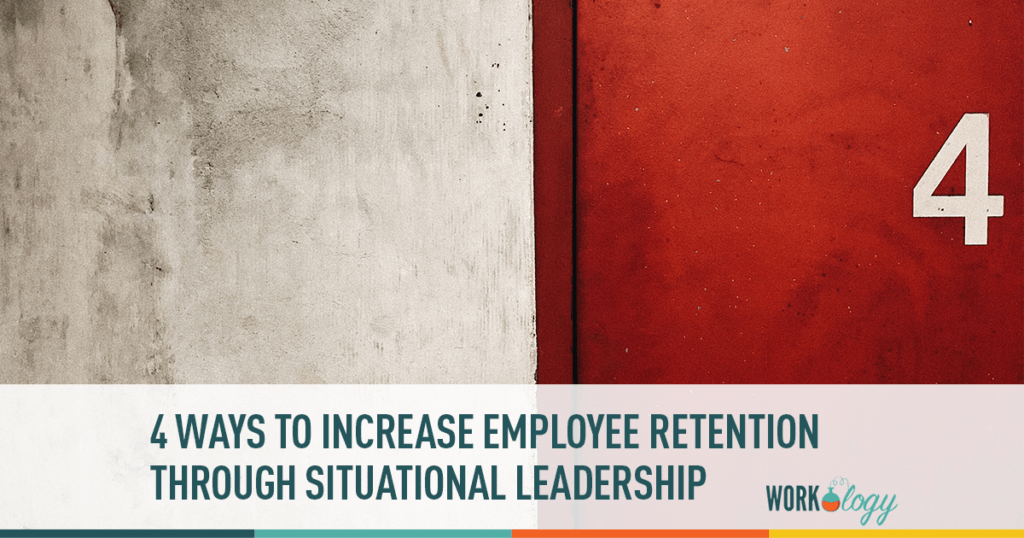Human Capital Management is a term used to describe the process of employing people, developing their capabilities,utilizing and managing, and compensating their services in tune with the job and the organizational requirement. Collaboration on the other hand is a process where two or more people work together to realize shared goals. As a leader within an organization, one will employ varying levels of development, leading, and leveraging the human capital or employee talent. Both involve varying levels of employee engagement.
4 Ways to Increase Employee Retention Through Situational Leadership
We all know that employee development and engagement can lead to an increase in employee retention. Gallup reports that in 2003, that actively disengaged workforce may cost the American economy up to $350 billion per year in lost productivity not to mention the estimated turnover cost of 150% of the annual salary of every open position. Two weeks ago, I shared with your some startling numbers based on a recent study by the CornerStone Demand and Harris Interactive where more than 21 million American workers will change jobs in 2012. The potential for lost productivity, revenue, and turnover is mind boggling with an estimated $2 Trillion.
Situational leadership, is a theory your manager or leadership can employ where leaders use varying leadership styles given the situation at hand. Because let’s face it even if the CornerStone’s study is 50% wrong, turnover and lost productivity will still cost U.S. companies upwards of $1 trillion next year. Employees are seeing a clear disconnect between what their employers are promising and what they are delivering. If a manager really wants to make a difference and salvage their team from jumping ship or mentally checking out, they learn to employ situational leadership strategies to better connect, engage, and motivate their workforce.
SITUATIONAL LEADERSHIP ISN’T A ONE SIZE FITS ALL
Traditionally, there are four types of situational leadership that require varying levels of Directive Behavior or Supportive Behavior. Managers can use a combination of techniques depending on the individual employee taking into consideration the best factors to individually motivate and connect with said employee. That means doing a couple things even before initiating a situational leadership strategy to begin with:
- Develop a Talent and Succession Planning Strategy. A solid strategy gives your management team as well as yourself a guideline and helps secure the vision. Change stops from the top down and by focusing on developing a talent pipeline and roadmap for managers to develop and grow their own teams, you increase the likelihood of higher employee retention rates.
- Provide Training to Define Rules & Expectations. With situational leadership, one of the most important ways to provide employees with opportunities to engage, develop, collaborate, and train is to provide a road map for success. Managers must have clear employee retention strategies and a leadership development plan with defined activities and communication points to keep expectations defined. Using employee-training programs during onboarding, quarterly training, or online training tools can help provide candidates insight into the development process and support the company’s overall mission and message.
- Communication. Communication. Communication. Employee engagement happens only when there is a conversation. Encourage employee one on ones, skip level meetings or interviews, and messages that encourages conversations among employees, their supervisors, and leaders within an organization. Employee communication can be on a formal and informal basis. Less talking and more listening from you the manager of your people. Take notes, ask questions, and be involved. Rinse and repeat.
- Assess company culture and engagement from multiple angles. Not every employee sees the value of a program, training, or initiative from the same points of view. Our unique perspective is what makes an individual an individual. Acknowledge that by first working with pilot programs to work out the kinks before your organization launches a full-scale situational leadership program to change the world. Some of the best tactics and plans are developed rogue and on the fly. Encourage creativity and growth within your own teams when it comes to talent retention programs and strategies where pilot programs are encouraged instead of discouraged.
THE SECRET SAUCE TO AN ENGAGED & HAPPY WORKFORCE
Unfortunately, there is no magic formula to creating an engaged workforce that invokes positivity, creativity, and the spirit of an organization. What may be more important than your organization’s awareness and recognition is the manager’s involvement in developing his/her team’s dynamic while also focusing on building relationships that encourage collaboration, engagement within your human capital management and employee retention strategy.










2 Comments
Great article but there more to it than just engaging the managers and formal leaders in being adaptable and proactive. The folks that originated Situational Leadership, the Center for Leadership Studies at http://www.situational.com, have a relatively new program for “followers” so they can get in the act “situationally” speaking. It’s called “Taking Charge” and it’s all about “owning your readiness” and asking for the leadership you need. At it’s core as the name suggests, it’s about giving employees the tools they need to lead up and take personal responsibility for their performance and development. CLS has a cool web course and for learning leaders that want to use a more traditional modality, they offer a packaged workshop version. IMHO it’s a potentially an enormously important advancement of the Situational Leadership model in that it serves to foster culture in which people become more actively engaged while growing to be all the more successful and effective at their jobs.
Thanks for the comment Randy. This post was more of an introduction prior to leveraging the situational leadership theory. I had not heard for the new programs for followers. I will check it out and thank you for your comments. I plan on writing more about situational leadership and will check out the site and information you are referencing.
JMM
Comments are closed.